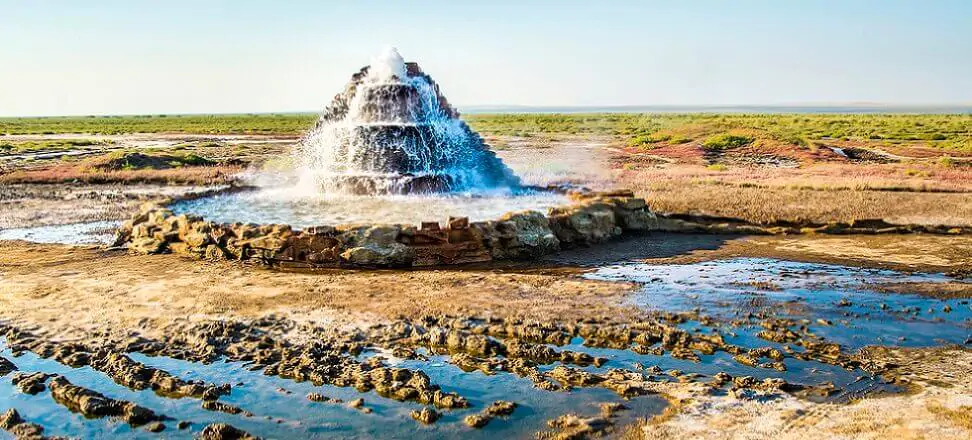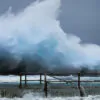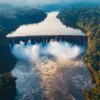Issue 7/2024, News
The Aral Sea has almost disappeared, but this is not the end of the disastrous news – which will be next?
Back in the first half of the 20th century. was the fourth largest lake in the world, today it is virtually non-existent. The Aral Sea is a sad example of reckless human activity that not only drastically changes the landscape on Earth, but proves to be a double-edged sword. The environmental catastrophe, dubbed one of the world’s biggest by UN Secretary Ban Ki-moon, has been accelerated by advancing climate change. And it could be even worse.
How man destroyed the Aral Sea
Located between Uzbekistan and Kazakhstan, the Aral Sea was in fact a lake. The misleading name comes from its huge surface area (68 thousand. km2), of which, unfortunately, only 10 percent remains. And it all started with an ambitious project. By the 1960s. Last century, the Aral Sea was fed by two huge rivers: the Amu-darya and the Syr-darya. Flowing down from the high mountains of the Tienshan, Pamir and Hindu Kush, they crossed the Kyzyl-kum desert and merged at the lowest point, where they created a paradise for many species of fish. Soviet planners decided to use the desert areas for the benefit of the Soviet people and diverted the two rivers to them. The result was cotton plantations, farmland and… a serious environmental problem.
The Aral Sea has begun to dry up. First it split into two parts, the northern and southern, and later four smaller lakes were created. In 2009. The southeast basin has disappeared completely, and a narrow band of water remains from the west basin. Satellite images taken by NASA in 2014. revealed that a new desert, named Aral-kum, had been created on the former bottom. In an attempt to save the remains of the lake, local authorities in 2005. built the Kok-Aral dam, which allowed the Northern Aral Sea to partially regenerate. Thanks to this initiative, the water level was raised by 12 meters in 5 years and local fisheries were partially restored.
Tragic consequences of the Aral project
The mere fact that one of the world’s largest lakes has disappeared does not capture the full drama associated with the controversial project. The infrastructure that was built turned out to be inefficient and its operation excessive. Subsequent neglect of its maintenance, combined with high emissions, has led to the practical extinction of a region that was once a mecca for tourists and, above all, a center for fishing – the main source of income for the local population.
As a result of evaporation, the salinity of the water that remained in the basin of the former Aral Sea increased tenfold, to 100 g/l, so that particular species of fish began to die out. The salinity of groundwater has also increased, exceeding the standards set by the World Health Organization for drinking water. Salt and sand storms began to plague the area, resulting in one of the highest dust deposition rates in the world. If that weren’t enough, the dust included fertilizers, pesticides and other chemicals used in crops, as well as heavy metals from the mining industry developed in nearby deserts. As a result, between 1980 and 2000, the former Aral Sea region experienced a decline in fertility, higher infant mortality, developmental delays and kidney disease in children, as well as an increased incidence of cancer.
Will the Caspian Sea be next?
The Aral Sea has been a victim of reckless human engineering, but climate change has also contributed to its accelerated decline. Rising temperatures increase the rate of water evaporation and lead to desertification of coastal areas. Unfortunately, similar alarming changes are already being observed in the Caspian Sea, which is officially the largest lake in the world.
Thanks to the MODIS technology used by NASA, it was possible to visualize the changes that took place between 2006 and 2022. They indicate a marked loss of water in the western part of the reservoir while the delta of the Volga, the largest river feeding the Caspian Sea, is drying up. According to scientists, by the end of this century, the water level in this fairly shallow lake could drop by a further 8-20 meters.
In addition, in the catchment area of the rivers feeding the Caspian Sea, 14,000 dams have been built over the past 90 years to supply water for irrigation systems, industry and households. Evaporation of water from dams combined with climate change poses a serious threat to the well-being of millions of people, local economies and ecosystems. It is worth noting that the region is home to 130 species of fish, including many endemic ones, and more than 100 species of birds nest in the surrounding wetlands. Their fate is in question today.

 Polski
Polski







